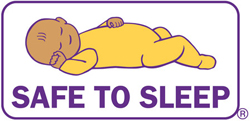Revised recommendations incorporate latest research on sleep-related risks to infants

Federal agencies concerned with in fant health and welfare today announced their support of the American Academy of Pediatrics (AAP) updated recommendations on safe infant sleep.
The Eunice Kennedy Shriver National Institute of Child Health and Human Development, part of the National Institutes of Health, the Centers for Disease Control and Prevention, and the Maternal and Child Health Bureau of the Health Resources and Services Administration and the U.S. Food and Drug Administration urge everyone who cares for infants younger than 1 year of age—parents, grandparents, family members, child care providers, health care providers, and others—to learn about the updated recommendations for safe infant sleep. The Safe to Sleep® campaign will update its educational messages to reflect these updated recommendations and will continue spreading the word about ways to reduce the risk of Sudden Infant Death Syndrome (SIDS) and other sleep-related causes of infant death.
The latest AAP recommendations include 19 overall guidelines for reducing the risk of SIDS and other sleep-related causes of infant death. The primary recommendation for reducing the risk of SIDS remains the same: place babies completely on their backs to sleep for all sleep times, naps and at night. Nine of the recommendations relate directly to the infant’s sleep environment. For example, one recommendation is to place baby to sleep on a firm sleep surface, such as a mattress in a crib that meets the safety standards of the U.S. Consumer Product Safety Commission. Another advises the removal of blankets, soft objects, toys, crib bumpers, and loose bedding from the sleep area.
The updated recommendations also emphasize that couches and armchairs can be very dangerous places for babies. Research described in the recommendations suggests that this is especially true if adults fall asleep as they feed, comfort, or bond with baby while on these surfaces. The AAP guidelines emphasize that parents and other caregivers should be aware of how tired they are when feeding, comforting, or bonding with baby while on these surfaces to avoid falling asleep in such situations.
For a complete list of the AAP’s revised recommendations on safe infant sleep, visit:
Policy statement: http://pediatrics.aappublications.org/content/early/2016/10/20/peds.2016-2938 
Technical report: http://pediatrics.aappublications.org/content/early/2016/10/20/peds.2016-2940 
In 1994, the National Institutes of Health, AAP, and other federal and national organizations launched the Back to Sleep campaign to educate caregivers about placing infants on their backs to sleep to reduce the risk of SIDS. Since then, the U.S. SIDS rate has fallen by an estimated 60 percent.
In 2012, the collaborators expanded the campaign to address not only SIDS, but also sleep-related causes of Sudden Unexpected Infant Death, or SUID. They named the expanded campaign Safe to Sleep®. The SUID category includes suffocation by soft bedding, overlay (when another person rolls on top of the infant during sleep), wedging or entrapment (infant gets trapped between two objects), and strangulation. Safe to Sleep® campaign messages reflect the AAP recommendations to reduce the risk of SIDS and other sleep-related causes of infant death.
###
About the Eunice Kennedy Shriver National Institute of Child Health and Human Development (NICHD): NICHD conducts and supports research in the United States and throughout the world on fetal, infant and child development; maternal, child and family health; reproductive biology and population issues; and medical rehabilitation. For more information, visit NICHD’s website.
About the National Institutes of Health (NIH): NIH, the nation's medical research agency, includes 27 Institutes and Centers and is a component of the U.S. Department of Health and Human Services. NIH is the primary federal agency conducting and supporting basic, clinical, and translational medical research, and is investigating the causes, treatments, and cures for both common and rare diseases. For more information about NIH and its programs, visit http://www.nih.gov.

 BACK TO TOP
BACK TO TOP